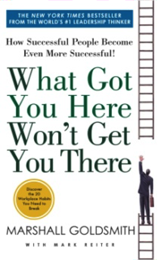January 2015: In This Issue
Welcome to the January 2015 edition of A New Leaf! The beginning of each year offers us the opportunity to reflect on how successful we have been in our leadership role over the past twelve months. Questions for consideration in this important self-assessment may include:
- How did my organization perform in meeting all of its 2014 goals? What were the root causes of the shortfalls? How could they have been avoided?
- How successful have I been in building a “culture of excellence” driven by A players?
- How well have I defined our organizational strategy around being “unique” in the marketplace….and is it working?
- Was I the best leader I could be in 2014? What steps have I taken to further develop my leadership capability and capacity?
Answers to these and other important questions are integral to formulating your 2015 leadership and organizational improvement plan.
Significant literature exists on the topics of how to improve your leadership capabilities. The author of this newsletter’s reading, “What Got You Here Won’t Get You There” takes a different approach to leadership development. Marshall Goldsmith, renowned Fortune 500 leadership coach, accepts that you have successfully done many things to get to your current position. Instead of focusing on those leadership attributes that have been instrumental in your success, he instead has identified those habits that may be holding you back from improving your performance. More than likely, continuing these habits is standing in the way of “getting you there” or where you would like to be in the future.
As you reflect on your personal development over the past year, consider what specific actions you have taken to consciously curtail unproductive behaviors. Goldsmith’s list of Twenty One such habits provides you with a great place to start for formalizing your “don’t do” list for 2015.
Best of luck as you work to refine your Exemplary Leadership Practice of Modeling the Way by discontinuing habits that are preventing you and your team from getting where you need to be. No one but you can make that happen!- Mike
 Book Review: “What Got You Here Won’t Get You There”
Book Review: “What Got You Here Won’t Get You There”
Marshall Goldsmith is widely recognized as the world’s foremost executive coach. He has worked with over 150 major CEO’s and their teams. Business Week has recognized him as one of the most influential practitioners in the history of leadership development. It is this hands on, practical experience that makes his book “What Got You Here Won’t Get You There” (WGYT) a credible source for those leaders looking to continue their self development journey.
Goldsmith begins WGYT detailing “The Trouble with Success” by illustrating real life case studies where leaders continuing habits have served to sabotage their ability to improve their performance. He uses these examples to launch into a discussion of “The Success Delusion or Why We Resist Change”, elaborating on the following four beliefs that are common to successful leaders but ultimately impede their ability to change:
- I Have Succeeded
- I Can Succeed
- I Will Succeed
- I Choose to Succeed
The “I Have Succeeded” belief gives rise to those that have experienced success in the past naturally feeling that the future will be no different. This unfounded degree of confidence serves to be unproductive as circumstances are never static and most often require significant behavioral change. To the extent leaders rely upon only what has gotten them there in the past, they will rarely succeed in making the changes necessary to get them to where they need to be in the future.
The “I Can Succeed” belief, while also being grounded in past success, results in an individual believing that they can make things happen through the sheer power of their own force or talent. In today’s team environment, this is rarely the case. Leaders succumbing to this belief will require a significant behavioral change away from I to WE to continue their success.
Leaders encumbered by an “I Will Succeed” belief are characterized by an excessive sense of optimism resulting in a continuous practice of over committing. This practice inevitably impairs a leader’s development as they rationalize away the critical need for change due to not “having the time” arising from their misplaced focus on less important but higher prioritized commitments.
The final “I Choose to Succeed” challenge arises from a leader’s strong belief that what they are doing is a direct result of their own choice. This belief significantly decreases the likelihood of a leader changing their behavior given the strength of their commitment arising from explicitly choosing what they are now doing. Accordingly, even when circumstances dictate a change in behavior, leaders will hold on to doing things as they have, for that has been their own choice.
The combination of the above beliefs serve as the basis for Goldsmith’s SUCCESS DELUSION which gives rise to leader’s overestimating their contribution to the success of an organization, willingness to take credit for the success of others and overall resistance to change. Such a delusion often ignores the failures and dead ends that the leaders themselves have created while they instead choose to focus on their own perception of success, real or unreal. When challenged, these “successful” leaders believe it is others that are confused and often enter a state of denial while trying to discredit the messenger. This delusional tendency contributes to an attitude of strong resistance to change which ultimately keeps the leader where they are instead of allowing them to ascend to where they need to be.
Overcoming this SUCCESS DELUSION requires a determined focus on change of unproductive habits by leaders. Goldsmith identifies in “The Twenty Habits That Hold You Back From the Top” those behaviors that belong on all leaders “don’t do” list. These habits generally are annoying to others, are reasonably easy to fix, if desired, and stand in the way of a leader’s self development. As you review the following list of Goldsmith’s Twenty Habits below, consider how many you fall prey to every day:
| • Winning too Much | • Adding too Much Value |
| • Passing Judgement | • Making Destructive Comments |
| • Starting with No, But or However | • Telling the World How Smart We Are |
| • Negativity, or Let me Explain Why that Won't Work | • Speaking When Angry |
| • Withholding Information | • Failing to give Proper Recognition |
| • Claiming Credit we Don't Deserve | • Making Excuses |
| • Clinging to the Past | • Playing Favorites |
| • Refusing to Express Regret | • Not Listening |
| • Failing to Express Gratitude | • Punishing the Messenger |
| • Passing the Buck | • An Excessive Need to be "ME" |
Goldsmith concludes WGYT by discussing Goal Obsession as a critical Twenty First Habit to be discontinued. This habit itself isn’t a flaw but a root cause of many related poor behaviors. It most often arises from two sources:
- Truly not understanding what you want to do in life
- A misunderstanding of what others want you to do
Those that don’t understand what is meaningful to them choose instead to pursue alternative goals relentlessly, oftentimes forsaking what is most important to them. These leaders find only too late that the goals themselves were not what matters most. Do you know anyone obsessed with making more money to support their family only to forget or ignore the family they are trying to support?
Similarly, to the extent one misunderstands a goal that has been set for them, they may often adopt less than productive methods to ensure the goal is met. This in the long run serves to hurt all parties and results in their failure to appreciate or put into perspective the real reason for the goal setting process.
How are you doing with being goal obsessed or addressing the Twenty Habits that are impacting your successful behavior? Are you closely listening to those employees that make the real difference in moving your company forward? Are you expressing gratitude to your team every day? Do you find yourself more concerned about your opinions than others? How frequently are you making destructive comments when others offer their opinions?
There is no better time than now to review Goldsmith’s Twenty One Habits as a means of formulating your leadership improvement plan for 2015. As you finalize this plan, give consideration to Goldsmith’s final chapter where he challenges the reader to look forward to when you may be 95 and reflect upon what was really important during your life. Based upon interviews with people who were near death, their common thoughts included “to find happiness in the moment….not in hopes of something in the future that may or may not materialize”, “to surround yourself with family and friends”, and “to follow your dreams”. Maybe that’s what “GETTING THERE” is really all about.
©2013 See Change Management. All Rights Reserved. Site credit


